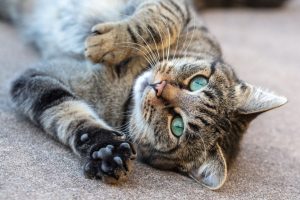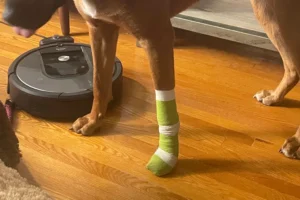Are you puzzled by your cat’s red claws? Let’s uncover the mystery behind this phenomenon.
Have you noticed redness on your cat’s claws and wondering what might be causing it? Here’s why your cat’s claws may appear red:
Potential causes of red claws
If you’ve noticed that your cat’s claws are red, there could be a few reasons behind it. One possible cause could be an injury to the claw or the surrounding area. Sometimes, cats can get their claws caught on something, leading to minor cuts or abrasions that may result in redness. Another common cause could be an infection, either in the claw itself or in the tissue around it. Infections can cause redness, swelling, and discomfort for your furry friend. Additionally, red claws could be a sign of underlying health issues such as anemia or other blood disorders. These conditions can affect the color and health of your cat’s claws, so it’s important to consult with a veterinarian if you suspect something more serious. Overall, keeping an eye on your cat’s claws and monitoring any changes in color is crucial to maintaining their overall health and well-being. If you’re unsure about the cause of the redness, don’t hesitate to seek professional advice from a vet.
Signs to watch for
When it comes to monitoring your cat’s claws for potential issues, there are some key signs to watch out for. One common indicator of a problem is if your cat is constantly licking or biting at their claws. This behavior could be a signal of pain or discomfort in the claws or surrounding areas. Another sign to keep an eye on is if you notice any changes in your cat’s behavior, such as limping or avoiding putting weight on a particular paw. This could indicate that there is an issue with one of their claws that needs attention. If you observe any swelling, redness, or discharge around the claws, it’s essential to investigate further as these could be signs of infection or injury. Being vigilant and proactive in monitoring your cat’s claws can help catch any potential problems early on and ensure your feline friend stays healthy and happy.
Tips for examining your cat’s claws
When you notice that your cat’s claws are red, it’s essential to carefully examine them to determine the cause. Start by gently holding your cat’s paw and inspecting each claw. Look for signs of injury, infection, or inflammation. If you see any cuts, swelling, or pus, it’s crucial to seek veterinary attention promptly.
Inspect the area around the claws for any redness, swelling, or discharge. Red claws could indicate an underlying issue like an infection or an allergic reaction. If you notice any unusual symptoms, such as limping, excessive licking of the paws, or changes in behavior, it’s best to consult your vet as soon as possible.
Ensure your cat’s claws are trimmed regularly to prevent overgrowth, which can lead to discomfort and potential health issues. Use specialized cat nail clippers and follow a vet-recommended trimming schedule.
If you suspect that your cat’s red claws are caused by a medical condition, consult with your vet for a proper diagnosis and treatment plan. Remember, early detection and intervention are key to ensuring your cat’s well-being.
When to see a vet
If you’ve examined your cat’s claws and notice persistent redness, swelling, or signs of infection, it’s time to schedule a visit to the vet. Red claws could be a sign of an underlying health issue that requires professional attention.
Other red flags that indicate the need for a vet visit include changes in your cat’s behavior, such as increased sensitivity or reluctance to use their paws. Additionally, if you observe any bleeding, discharge, or unusual odor around the claws, seek immediate veterinary care.
Keep in mind that cats are experts at hiding pain and discomfort, so it’s essential to pay close attention to any subtle changes in their behavior or appearance. Trust your instincts as a pet parent and prioritize your cat’s well-being by seeking veterinary guidance when in doubt.
Schedule regular check-ups with your vet to monitor your cat’s overall health and address any concerns promptly. Prevention and early intervention are key to maintaining your cat’s paw health and overall quality of life.
Additional tip: Consider using a scratching post to help keep your cat’s claws healthy and reduce the risk of overgrowth or injury.
Preventing red claws in cats
If you’ve noticed your cat’s claws looking red and irritated, it might be a sign of an underlying issue. One common reason for red claws in cats is inflammation or infection in the nail beds. This can be caused by a variety of factors, including trauma, ingrown nails, or even a bacterial or fungal infection. To prevent red claws in your feline friend, here are a few tips:
- Regular grooming: Keeping your cat’s claws trimmed can help prevent them from becoming overgrown and causing irritation. If you’re unsure how to safely trim your cat’s nails, consult your veterinarian for guidance.
- Provide scratching posts: Cats instinctively scratch to remove the dead outer layers of their claws. By providing scratching posts or pads, you can help your cat keep their claws healthy and reduce the risk of inflammation.
- Monitor for signs of infection: Keep an eye out for any signs of infection, such as redness, swelling, or discharge around your cat’s claws. If you notice any of these symptoms, it’s best to consult your vet for proper diagnosis and treatment.
By following these simple tips, you can promote overall paw health and help prevent red claws in your beloved feline companion.
Interesting facts about cat claws
Cat claws are truly fascinating and serve a variety of functions beyond just scratching furniture. Did you know that a cat’s claws are retractable, allowing them to remain sharp for hunting and self-defense? Here are some more interesting facts about cat claws:
- Claw anatomy: A cat’s claws are made of keratin, the same protein that makes up human fingernails. However, unlike human nails, cat claws are curved and pointed, perfect for catching and holding prey.
- Sharpening behavior: Cats sharpen their claws by scratching on surfaces to remove the outer dead layer, revealing a sharp new claw underneath. This behavior is crucial for maintaining healthy claws.
- Communication tool: Cats use their claws not just for climbing and hunting but also for communication. They may knead with their claws to show affection or mark their territory by scratching.
Understanding these unique characteristics of cat claws can help you appreciate the importance of proper claw care for your furry friend. So, next time your cat stretches out their claws, remember all the amazing functions they serve beyond just scratching.
Cat claw grooming essentials
Keeping your cat’s claws healthy is essential to prevent redness and other issues. Here are some basic cat claw grooming essentials to keep in mind:
- Regular Trimming: Make sure to trim your cat’s claws regularly to prevent overgrowth and potential injuries.
- Scratching Posts: Provide your cat with appropriate scratching posts to help them naturally maintain their claws.
- Claw Covers: Consider using claw covers to prevent scratching and reduce the risk of claw redness.
- Proper Diet: Ensure your cat has a balanced diet to promote overall health, which can also impact claw health.
Remember, grooming your cat’s claws should be a gentle and positive experience to avoid stress and discomfort for your furry friend.
Understanding claw discoloration in different cat breeds
Claw discoloration can vary among different cat breeds, and various factors can contribute to this variation. Here are some insights to help you understand claw discoloration in cats:
- Genetics: Certain cat breeds may naturally have reddish claws due to their genetic makeup.
- Activity Level: High-energy cats that use their claws frequently may experience more wear and tear, leading to redness.
- Health Issues: Underlying health problems, such as infections or inflammatory conditions, can also cause claw discoloration.
- Dietary Factors: A poor diet lacking essential nutrients can impact the health of your cat’s claws.
If you notice persistent redness in your cat’s claws, it’s essential to consult with your veterinarian to rule out any underlying health issues and ensure your feline companion receives the necessary care.
Promoting overall paw health
When it comes to promoting overall paw health in your feline friend, there are a few key things to keep in mind. First off, regular nail trims can help prevent your cat’s claws from becoming red and irritated. This also reduces the risk of ingrown nails, which can be painful for your pet. Additionally, providing appropriate scratching posts can help satisfy your cat’s natural urge to scratch and keep their claws healthy.
In addition to these basic steps, ensuring your cat gets enough exercise is crucial for their overall paw health. Cats need plenty of physical activity to keep their muscles and tendons strong, which in turn supports healthy paws. Interactive play sessions, such as chasing a laser pointer or feather toy, are ideal for keeping your cat moving and engaged.
Lastly, don’t forget about proper nutrition. A well-balanced diet rich in essential nutrients like omega-3 fatty acids can help support your cat’s overall paw health, including their claws. Remember, a healthy cat is a happy cat!
Additional tip:
- Regularly inspect your cat’s paws for any signs of redness, swelling, or discharge. This can help catch any issues early and prevent further complications.
Alex, a passionate animal lover, has experience in training and understanding animal behavior. As a proud pet parent to two dogs and three cats, he founded AnimalReport.net to share insights from animal experts and expand his knowledge of the animal kingdom.









